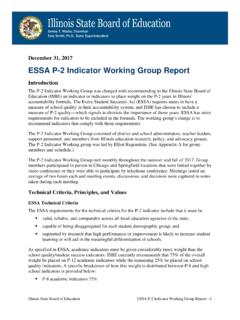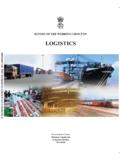Transcription of Report of the LPG Independent Expert Working …
1 Final Report , November 14, 2011. Report of the LPG Independent Expert Working group Executive Summary This is the Report of an Independent Working group (WG) established by HSE in May 2011 to advise on the prioritisation and timescale for resolution of potential corrosion problems with underground LPG vapour-carrying pipework installed at industrial and commercial premises. The remit of the WG was limited to reviewing progress with the resolution of such pipework issues and making recommendations concerning the time scales for any future steps while considering the levels of risk present in a wider context as part of normal business operations. Following Lord Gill's Report into the accident at the ICL Plastics Ltd factory in 2004, the government accepted Lord Gill's recommendation that underground metallic pipework should be replaced.
2 HSE and the LPG supply industry then worked together during 2009 to commission a survey of commercial and industrial users of LPG. The information obtained was used in a computer model to prioritise pipework based on the risk of gas ingress into a building as a result of corrosion failure of the metallic service at a particular installation. From the available information, about 4,000 premises out of a total of 18,000 were deemed to be higher priority. The higher risk premises were further divided into three categories (A-C) and the owners were advised that at-risk pipework should be replaced (or that other appropriate risk reduction action resulting in a resolution, see examples below, should be taken) by the end of 2013. Owners of the remainder of the 18,000 premises, categorised as D-E, were advised that they should do likewise by the end of 2015.
3 To date over 1,000 of the around 4,000 higher priority (A-C) premises have been resolved either through replacement of underground metallic pipework, or through improved information which established that replacement was not necessary in the 2013 timeframe. The rate of resolution of such premises is currently about 350-400 per month, with a peak rate of replacements of about 200. per month (those not replaced being resolved through improved information), reflecting the limited financial and qualified personnel resources available for such work. Having reviewed progress to date and the numbers of higher priority premises still to be resolved, we conclude that it is feasible to complete the resolution of the A-C group by the end of 2013, and we recommend that this programme should continue.
4 As regards the remaining premises (~14,000) in the D-E categories, we conclude that, with currently available resources, it is not feasible to complete the resolution of all these installations by 2015. The ramping-up of the replacement rate that would be required is not justifiable in view of the relatively low levels of risk involved. Having reviewed the factors that determine risk in light of HSE's and the industry's current knowledge of LPG users' premises and gas installations, we recommend that these premises should be re-prioritised for action as follows: Priority 1: Premises with medium pressure carbon steel pipework aged 10 years old or more at the time of the 2009/10 survey AND where any one or more of the factors listed below apply should be resolved by the end of 2015.
5 A) Regularly occupied by members of the public or LPG Independent WG Final Report Page 1 of 42. Final Report , November 14, 2011. b) regularly occupied by more than 5 other persons, or c) a cellar, basement or other significant below-floor void is present. Priority 2: Any other premises with carbon steel pipework should be resolved by the end of 2020. Priority 3: Any other premises with metal pipework which is not carbon steel ( copper) should be resolved by the end of 2025 unless the pipework is known to be BOTH aged less than 35 years at the time of the 2009/10 survey, AND to be operating at low pressure (75 mbar or below), in which case it may remain in place for the 50 year recommended life of such pipework. For the avoidance of doubt, in the context of this Report resolution means that concerns regarding the risk of LPG leakage into buildings from corroded underground supply pipework have been satisfactorily addressed in that, for example, one or more of the following apply: The installation has been examined and there is no underground carbon steel pipework (for example it is found to be PE or copper or the pipework is above ground).
6 Underground carbon steel pipework has been replaced by an alternative material and the installation tested. A risk assessment has been undertaken by a competent person and an inspection and maintenance programme has been agreed with the HSE. We recommend that any premises whose priority is indeterminate based on the information currently held by HSE and LPG suppliers should be treated as in the highest priority category consistent with such information as is known. That is, worst case assumptions should be used for all parameters such as pipework material, age and pressure that are not known. We hope that this will enable HSE and LPG suppliers to provide an incentive to LPG users to put in place installation records or otherwise to provide reliable comprehensive information. On the basis of these recommendations: About 2,850 premises are Priority 1 and will clearly require resolution by 2015.
7 A further 4,140 premises will require resolution by 2015 if pessimistic assumptions are made in place of missing information; however we suspect the majority of these may safely be able to be deferred when and if additional information is provided by LPG users and assessed by a competent person (LPG suppliers are currently pursuing users for this information). Approximately 5,200 further premises are Priority 2 and will require resolution by 2020. Around 1,300 premises with copper pipework are Priority 3 and could be deferred to 2025. or beyond. Our Report explains the basis on which we have reached these judgments, and in particular the basis of our associated conclusions a) that the risk associated with this hazard for the premises in question is low enough that substantial numbers of premises can safely be deferred for resolution until after 2015, b) that carbon steel is the pipework material at particular risk, and LPG Independent WG Final Report Page 2 of 42.
8 Final Report , November 14, 2011. c) that the age of carbon steel pipework installations, operating pressure, the occupancy of the premises concerned and the presence of a basement or cellar (or other under-floor void). provide the best available basis for re-prioritisation. We observed in the course of our work that substantial reductions in risk could be achieved by reducing the operating pressure of pipework. We recommend that, whenever pipework is to be replaced, the operating pressure of the new pipework should be as low as reasonably practicable taking into account the end use appliances and required gas throughput. For most domestic and many commercial LPG users this will result in pipework operating at Low Pressure (LP), which for the LPG industry means pressure not exceeding 75 mbar.
9 In conclusion we would like to acknowledge the very substantial efforts that have been made by HSE and LPG suppliers, along with LPG users, to improve the state of knowledge of LPG. installations, including the promotion of installation records, and factors relevant to the risk of pipework corrosion underground since the publication of Lord Gill's Inquiry Report . Peter Lindstedt (chairman), Barbara Lowesmith, Tony Taig and Richard Wigfull The HSE LPG Expert Working group LPG Independent WG Final Report Page 3 of 42. Final Report , November 14, 2011. Contents Report of the LPG Independent Expert Working group .. 1 Executive Summary .. 1 Contents .. 4 1. Introduction .. 5 2. Background to LPG Pipework Corrosion Hazard .. 7 LPG and LPG 7 Corrosion of Underground LPG Pipework .. 9 LPG Pipework Corrosion and Gas Accumulation in Buildings.
10 11 3. Progress to 16 Survey of LPG Users .. 16 Initial Prioritisation of Premises .. 17 Inspection and Enforcement Activity .. 17 Resolution of Underground Metal Supply Pipework .. 18 4. Prioritisation of Remaining Pipework .. 20 Risk Factors Identifiable from the GL Study .. 20 Other Risk Factors .. 21 Knowledge and Uncertainty about the D-E Premises .. 23 LPG Service Pipework Corrosion Risks in Perspective .. 24 Other LPG Users .. 28 5. Conclusions & Recommendations .. 31 Appendix 1: The Working group and Terms of Reference .. 35 Working group Membership .. 35 Working group Terms of Reference .. 36 Appendix 2: Prioritisation Factors from GL Analysis .. 37 Pipework Material .. 37 Pipework Age .. 38 Service 39 Presence of Cellar/Basement .. 40 Ground Cover outside 41 Appendix 3: Glossary.














